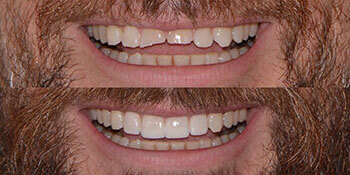Dental Scaling & Root Planing Toronto
Plaque is a sticky substance that adheres to the tooth structure and is teeming with bacteria. Over time, plaque becomes calcified (hardened) and at this stage, it becomes what is called calculus.
Plaque and calculus are irritants to the tissues of your mouth. The reaction of your body to the irritants and the subsequent gum inflammation, gum recession, bleeding and eventual bone loss around the teeth constitute periodontal (gum) disease.
The earliest stage of periodontal disease is called gingivitis (which is reversible) and is characterized by bleeding gums, especially when one brushes and flosses. If the disease is not addressed, it will progress to periodontitis, which is far more destructive, and is characterized by further gum deterioration, bone loss, and ultimately tooth loss.
Scaling and root planing are the most common form of treatment for periodontal disease. Scaling removes calculus (also called tartar) and plaque from the tooth surface above and below the gum line. Root planing improves smoothness of the root's surface and removes any remaining calculus.
When the amount of plaque and calculus to remove is extensive, the dentist will numb the area to make the procedure comfortable for you. A combination of sonic and hand instruments are used in the procedure. The sonic instruments remove the large deposits of plaque and calculus. Hand instruments are then used to remove any remaining tartar and ensure all surfaces of the crown and root are clean and free of bacteria. Sensitivity and soreness may be present a few days following treatment and usually can be relieved with over-the-counter pain relievers.
A follow-up visit with City Oasis Dental is usually scheduled for four weeks following treatment to check the improvement of gingival status, and regular intervals (3 month and 6 month intervals are typical) thereafter to monitor the disease. The goals are to eliminate the active inflammation caused by bacteria and reduce the periodontal pockets around the teeth so they cannot trap plaque or calculus, thus maintaining the present bone height around the teeth.
What is scaling and root planing?
Scaling and root planing is a deep cleaning procedure that dentists do to clean your teeth from built-up debris. During the scaling process, your dentist removes all the plaque and tartar from the surface of your teeth, under your gum line, and the bottom of the pocket.
Root planing happens after scaling. Your dentist smooths out the roots to help your gums better reattach to your teeth. The entire scaling and root planing process might take several visits to the dentist to complete.
Scaling and root planing can help treat periodontal disease by removing the irritants that cause tooth decay, infections, gum inflammation, gum recession, bone loss, and gingivitis.
Why is scaling important?
Scaling is important because it helps you maintain good oral wellness. There are lots of bacteria in your mouth and when the bacteria mixes with the sugary foods and drinks you eat, it creates plaque which eventually hardens to tartar. When you have too much plaque and tartar on your teeth, it causes many dental problems.
Routine scaling treatments with your dentist helps you maintain a cleaner mouth by removing the built-up plaque and tartar in your mouth. It also helps prevent future plaque build-up. As a result, you’ll be less prone to gum disease, tooth infections, and other problems like bad breath.
How is deep cleaning different from traditional dental cleanings?
During a traditional dental cleaning, your dentist focuses on scraping the plaque on the surface of your teeth. They also clean the gum line to scale and polish the outer surface of the teeth. This can remove bacteria that’s coating your teeth to help you maintain good oral health. The goal of routine regular cleanings is to help you prevent cavities and infections.
Deep cleaning is different because the process is more extensive and focuses on the roots of your teeth. Your dentist goes beyond the tooth’s surface to remove plaque and tartar that accumulates in the roots of your teeth and in the pockets. Root planing is only done during deep cleaning procedures.
What to expect from the deep cleaning procedure?
You can expect a two-step procedure that involves scaling and root planing. The dentist will first perform scaling to remove all the plaque and tartar from your teeth. They focus on the surface of your teeth, as well as the roots and the bottom of the pocket.
After the scaling process, they will smooth the roots of your teeth to help your gums reattach to your teeth. This encourages the gum to heal around the teeth where the plaque and tartar were. Lastly, your dentist will polish your teeth to protect them and give them a shine.
Why are scaling and root planing performed?
Built-up plaque and tartar causes many dental problems, such as gum disease, gingivitis, tooth infections, and tooth decays. Scaling and root planing cleans deep into the roots of your teeth and gum to prevent the build-up of bacteria to help you prevent these problems.

